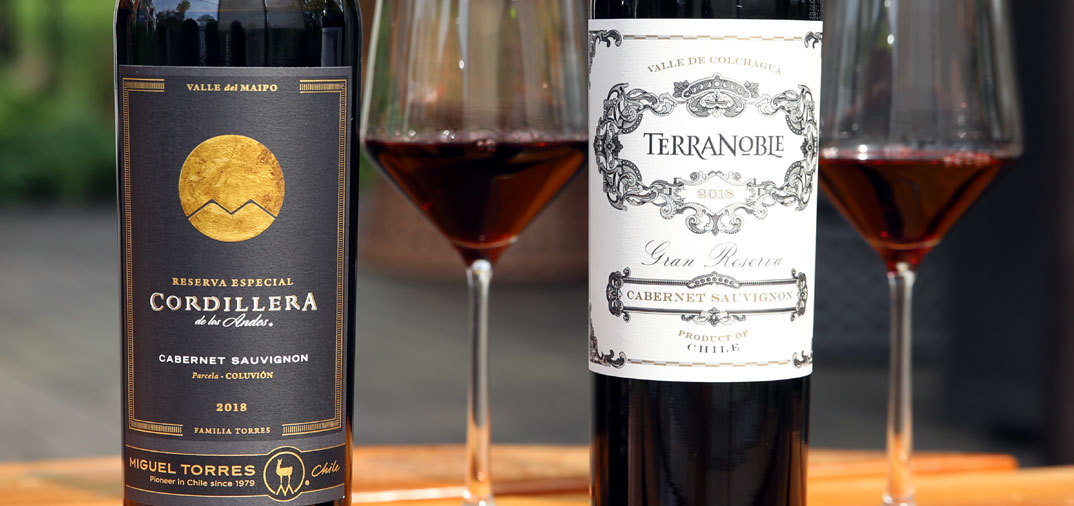
Cabernet Sauvignon: Maipo vs Colchagua, Round 1
I’ve been touting Chilean wines as outstanding bargains for several years now. And while I’ve highlighted wines from different regions of Chile, it can be difficult to keep track of which Chilean wine regions are best for different varieties of wine. I’ve been at this for years, tasted hundreds of Chilean wines and read extensively about the region and yet retaining knowledge about different Chilean wine regions still challenges me. I constantly have to go back to my notes and relearn.
I suppose this is due, in part, to the fact that I haven’t yet visited Chile. Visiting a wine region does wonders for your understanding of the region and the impact terroir has on its wines. If you’re into wine, I cannot overemphasize the value wine travel adds to your understanding of a wine region.
But alas, I’m not here to write about the wonders of wine travel… not today anyway. My mission today is to delve deeper into understanding a couple different Chilean wine regions, without the luxury of traveling there. The regions I’m exploring are the Maipo Valley and the Colchagua Valley and I’m looking at them in the context of Cabernet Sauvignon. This is round one of this comparison and I intend to do at least one more post comparing these regions.
Cabernet Sauvignon in Chile
Cabernet Sauvignon is the most widely planted red wine grape variety in Chile, accounting for about 20% of vines. Keep in mind that Chile is a long country with 2,700 miles of coastline and a lot of different wine regions up and down the length of the country. Interestingly, 97% of the Chilean land planted with Cabernet Sauvignon is within the Central Valley — which, as you might guess, is in the center of the country. Maipo Valley is a sub-region within the Central Valley and Colchagua Valley is a zone within the Rapel Valley, which is also a sub-region of the Central Valley. Therefore, what I’m comparing in this post are the differences between two valleys within the larger Central Valley.
Geography of Maipo and Colchagua Valleys
There are a whole lot of geographic details I could write about to describe these two regions, but honestly when I read that stuff I start to zone out because it’s hard to contextualize it without having been there and seen it first hand. Therefore, I’ll try to explain it concisely.
Both Maipo and Colchagua have mostly alluvial and some colluvial soils, although Colchagua Valley also has some granite-based soils. The Maipo Valley has higher altitudes than Colchagua Valley. The higher altitudes in Maipo result in a greater diurnal shift, which helps establish acidity and sugar development in the grapes. In the Colchagua Valley, the lower the altitude gets the warmer the average temperature.
For me, the altitude and related climate difference is the most significant factor between these wines. If you’ve read my blog for a while, you’ve probably learned that I’m a fan of high altitude wines. In my experience, high altitude wines tend to be more aromatic and vibrant than lower altitude wines and that proved to be true in this tasting.
Comparing the Wine
The wines for round one of the Maipo vs Colchagua face off are both from the 2018 vintage. Both are made from 100% Cabernet Sauvignon. Each have a suggested retail price of $20. And each have an alcohol level of 14%. The grapes for both wines were mostly grown in colluvial soil, although about a third of the grapes for the wine from Colchagua Valley are from alluvial soil.
Miguel Torres, Reserva Especial Cordillera de los Andes, Cabernet Sauvignon
This first wine comes from Miguel Torres in Maipo Valley. The nose of this wine is beautiful, spicy and lively, offering intense ripe cherry, raspberry, blackberry, nutmeg and garrigue. The palate is vibrant and delicious, with concentrated cherry and raspberry flavors with a touch of spice. The mouthfeel is nice, with a slight touch of tannins adding texture. It finishes fairly long, continuing to showcase the cherry flavors.
Wine: Miguel Torres, Reserva Especial Cordillera de los Andes
Varieties: 100% Cabernet Sauvignon
Vintage: 2018
Alcohol: 14%
Rating: 88
Suggested retail price: $20.00
Disclosure: This wine was received as a media sample.
TerraNoble, Gran Reserva, Cabernet Sauvignon
The second wine is from TerraNoble in Colchagua Valley. Herbals aromas, which in this wine I’d characterize as sage, oregano and tomato leaf, are prominent on the nose. There’s also some fruit aromas, such as cherry and blackberry. When you taste this wine, the mouthfeel is the first thing you notice because it is amazingly velvety. It tastes great too, offering tart cherry and blackberry flavors and a touch of bitter, astringent tannin, which really shows from the mid-palate into the finish. There’s an earthy quality to this wine, which makes it come to life more like an old world style. The acidity is good. It finishes really long, with tannins and red fruit that lasts for minutes.
Wine: TerraNoble, Gran Reserva
Varieties: 100% Cabernet Sauvignon
Vintage: 2018
Alcohol: 14%
Rating: 86
Suggested retail price: $20.00
Disclosure: This wine was received as a media sample.
To be clear, both of these wines are good, but they do have some stylistic differences. Which is better could, arguably, come down to preference. For me, the Miguel Torres (i.e., Maipo Valley) wins out based on aromatics and vibrant acidity. But the TerraNoble wins on mouthfeel. Overall, the Miguel Torres is my top pick.
Try for yourself. Go pick up a bottle from each region and taste them side by side. It doesn’t have to be these two either. Let me know what you think. Cheers!










